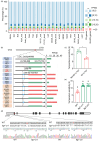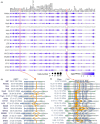Time-ordering japonica/geng genomes analysis indicates the importance of large structural variants in rice breeding
- PMID: 36196761
- PMCID: PMC9829401
- DOI: 10.1111/pbi.13938
Time-ordering japonica/geng genomes analysis indicates the importance of large structural variants in rice breeding
Abstract
Temperate japonica/geng (GJ) rice yield has significantly improved due to intensive breeding efforts, dramatically enhancing global food security. However, little is known about the underlying genomic structural variations (SVs) responsible for this improvement. We compared 58 long-read assemblies comprising cultivated and wild rice species in the present study, revealing 156 319 SVs. The phylogenomic analysis based on the SV dataset detected the putatively selected region of GJ sub-populations. A significant portion of the detected SVs overlapped with genic regions were found to influence the expression of involved genes inside GJ assemblies. Integrating the SVs and causal genetic variants underlying agronomic traits into the analysis enables the precise identification of breeding signatures resulting from complex breeding histories aimed at stress tolerance, yield potential and quality improvement. Further, the results demonstrated genomic and genetic evidence that the SV in the promoter of LTG1 is accounting for chilling sensitivity, and the increased copy numbers of GNP1 were associated with positive effects on grain number. In summary, the current study provides genomic resources for retracing the properties of SVs-shaped agronomic traits during previous breeding procedures, which will assist future genetic, genomic and breeding research on rice.
Keywords: Oryza sativa; japonica/geng; breeding process; de novo assembly; gene editing; structural variations.
© 2022 The Authors. Plant Biotechnology Journal published by Society for Experimental Biology and The Association of Applied Biologists and John Wiley & Sons Ltd.
Conflict of interest statement
The authors declare no conflict of interest.
Figures








References
-
- Altschul, S.F. , Gish, W. , Miller, W. , Myers, E.W. and Lipman, D.J. (1990) Basic local alignment search tool. J. Mol. Biol. 215, 403–410. - PubMed
-
- Barrett, J.C. , Fry, B. , Maller, J. and Daly, M.J. (2005) Haploview: analysis and visualization of LD and haplotype maps. Bioinformatics, 21, 263–265. - PubMed
-
- Blanco, E. , Parra, G. and Guigó, R. (2007) Using geneid to identify genes. Curr. Protoc. Bioinform. 18, 4–3. - PubMed
Publication types
MeSH terms
LinkOut - more resources
Full Text Sources

